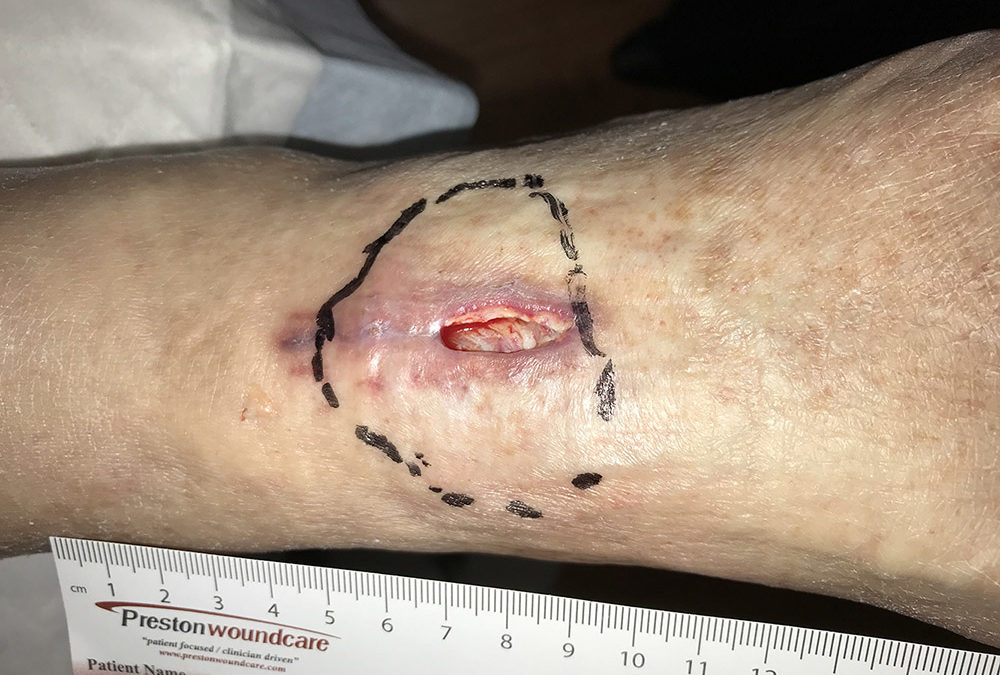Forget about the flu epidemic. At least it’s pretty easy to figure out when a patient has the flu. I feel sure I have missed some patients with wounds due to low Vitamin D. The Vitamin-D deficiency epidemic is ridiculous. What scares me is not that 80% of the tests I have drawn in the past 12 months have been low- and I mean really, really low – even in patients taking Vitamin D supplements. What scares me is how many I may have missed because I’ve only been really paying attention to this in the past year. I have blogged about this before, but honestly, I could put a case of Vitamin D Deficiency on my blog every week.
This is a 70 year old man who underwent podiatric surgery for a ganglion cyst in October. Ten days later when the sutures were removed, the wound just fell open. He underwent debridement and closure, and the same thing happened. The before photo shows the pale wound bed that has no granulation tissue. The circle I marked with a sharpie on the top of his foot is the area of undermining which is HUGE. There is no healing going on.

I’ve attached a vitamin D-OH report above. This one is 17 ng/ml. Anything less than 20 ng/ml is deficient. It needs to be >30 ng/ml to be normal. I prescribed 50,000 units once a week for 4 weeks. After 3 weeks, it’s a different wound entirely.
You may be thinking, “He probably has arterial insufficiency.” On the first visit of every patient, I perform an arterial screen with skin perfusion pressure or transcutaneous oximetry. His SPP was totally normal, as was his pulse volume recording. Nevertheless, lest you still think that he has arterial insufficiency, check out this video. It’s his Dorsalis Pedis artery pulsating in the wound bed on his first visit. At first I thought it was a muscle fasciculation, but then I realized, NO! That is just his atrial fibrillation. It’s amazing!

After 3 Weeks of Vitamin D
Here’s the link again to a great paper about Vitamin D Deficiency and wound healing that was published in Today’s Wound Clinic last November. I am not exaggerating that I reviewed this paper and then walked into a patient’s room and thought, “Wow, she could have this problem.” And she did. That’s the case I blogged on some months ago. TWC is such a terrific publication for that very reason- it’s got relevance to the issues you see every day- and I’m not just saying that because I’m the clinical editor. If you don’t get the printed copy every month, you are missing out because it’s a lot more fun to read in print than on line, plus you get to pass it around at lunch.
And, as promised, here is the video of a a pulsating Dorsalis Pedis artery… also caused by Vitamin D deficiency. I promise you, this footage will be memorable to say the least.

Dr. Fife is a world renowned wound care physician dedicated to improving patient outcomes through quality driven care. Please visit my blog at CarolineFifeMD.com and my Youtube channel at https://www.youtube.com/c/carolinefifemd/videos
The opinions, comments, and content expressed or implied in my statements are solely my own and do not necessarily reflect the position or views of Intellicure or any of the boards on which I serve.




Just curious, is the patient a diabetic? Well controlled?
I haveing majors problems a past surgery..I have wound get infected and had surgery to close it up and
It open up again ..look like exactly the same as picture . Nobody has ever checked my d panel…
I loved your blog and thanks for publishing this about don’t miss this vitamin d deficiency epidemic and yes that is a pulsating dorsalis pedis artery!! I am really happy to come across this exceptionally well written content. Thanks for sharing and look for more in future!! Keep doing this inspirational work and share with us.
I have a o.3 cm ganglion cyst extending from superior right facet joint into the junction of central canal and right neural foramen (inmy back) can that be cured?
Are gangolin cysts contagious? I’d never had one until being around someone who has a bunch. My vitamin D is also very very low. doctor just put me on 2000 iu a day.
The pulsating Dorsalis Pedis artery video is a tangible example of the systemic impact of nutrient deficiencies. As a personal trainer, my reliance on Vitamin B Complex for physical vitality is non-negotiable. Discovering the link between Vitamin D and wound healing has broadened my perspective. Just as I educate clients on B vitamins, I’m integrating discussions about the importance of Vitamin D.